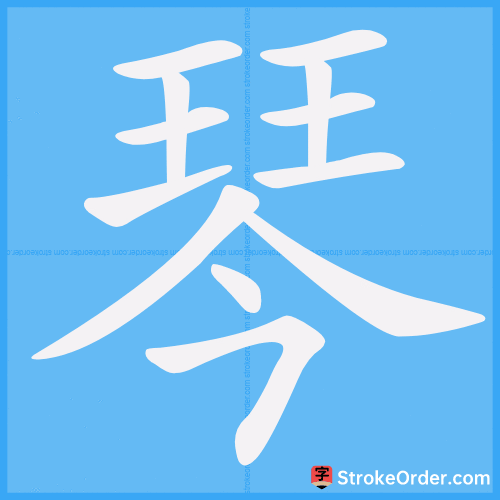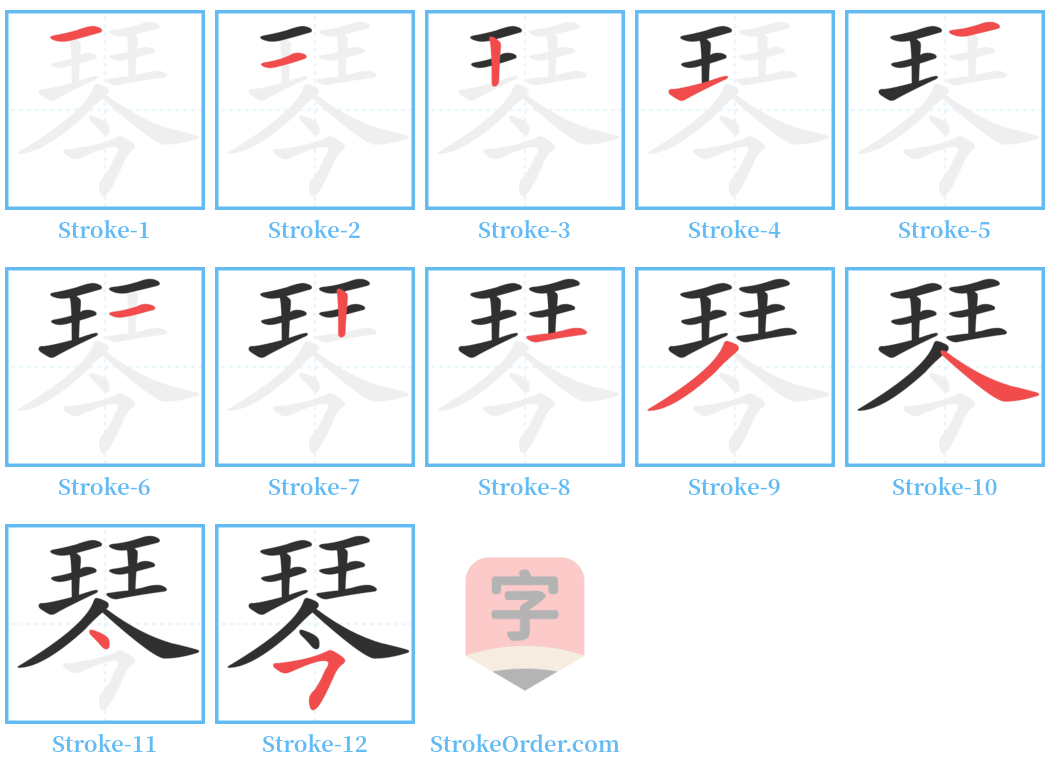琴 Stroke Order
Animated Stroke Order of 琴

Stroke Order Diagrams for 琴

Step-by-Step Handwriting Guide for 琴

Learn to Write Chinese Characters with Video Tutorials
Watch the video of writing the Chinese character "琴", learn the correct stroke order (笔顺) of the character "琴", and master the standard way of writing the character "琴".
Free Printable Handwriting Practice with Stroke Order: 琴
Printable Writing Practice Worksheet of "琴" in Portrait Orientation (Tian Zi Ge)

Printable Writing Practice Worksheet of "琴" in Landscape Orientation (Tian Zi Ge)

Information of 琴
Pinyin
qín
Radical
王
Strokes
12 strokes
Usage
★★★★★
Definition
(mus. instr.)
琴 (qín)
1. Ancient stringed musical instrument, originally with five strings, later increased to seven strings (also known as "seven-stringed instrument"; commonly referred to as "Guqin").
- Example: 琴瑟 (qin se), 琴曲 (qin qu), 琴师 (qin shi), 琴意 (qin yi), 抚琴 (fu qin), 琴棋书画 (qin qi shu hua).
2. General term for certain musical instruments.
- Example: 钢琴 (gang qin), 月琴 (yue qin), 胡琴 (hu qin), 口琴 (kou qin), 竖琴 (shu qin), 小提琴 (xiao ti qin), 琴书 (qin shu - a form of traditional art), 弹琴 (tan qin).
琴 (qín)
1. Basic meaning: a plucked string instrument. Commonly called Guqin.
- Etymology: Originally written as "珡". The small seal script represents the shape of the instrument, with "玨" symbolizing the strings and tension posts, and the bottom resembling the body of the instrument.
2. General name for certain musical instruments.
引用:
1. 《说文》: "琴, 弦乐也. 神农所作, 洞越练朱五弦, 周加二弦, 象形. 古文从瑟金省声."
2. 《广雅·释乐》: "神农氏琴长三尺六寸六分, 上有五弦, 曰宫商角徵羽, 文王增二弦, 曰少宫、少商."
3. 晋·陶渊明《归去来兮辞》: "乐琴书以消忧."
例:
- 如: 琴史 (qin shi - history of the instrument), 琴书 (qin shu - texts on the art of playing), 琴床 (qin chuang - table for the instrument), 琴柱 (qin zhu - post used to secure the strings).
琴 (qín)
2. General name for certain musical instruments.
- Example: 提琴 (ti qin - violin), 胡琴 (hu qin - type of string instrument), 钢琴 (gang qin - piano), 口琴 (kou qin - harmonica).
the four arts (zither, Go, calligraphy, painting) / the accomplishments of a well-educated person
Input Method for 琴
Pinyin
qin2
Wubi
ggwn
Cangjie
mgoin
Zhengma
ccsx
Four Corner
11207
Unicode
U+7434
Same Pronunciation Characters